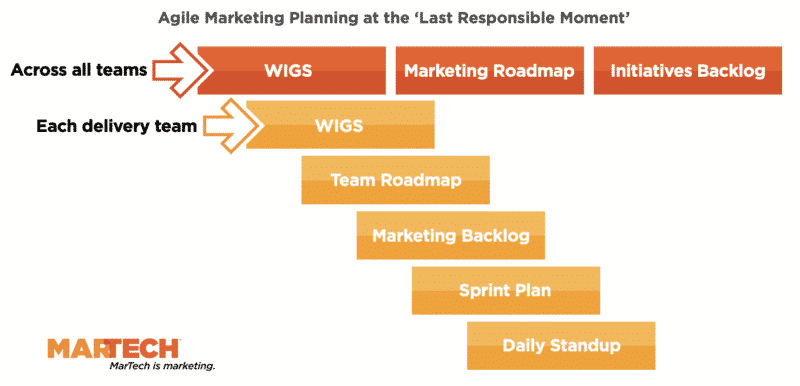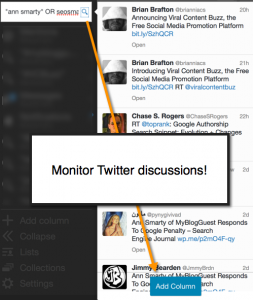Could your marketing plan become irrelevant if it’s too detailed too soon? Absolutely.
There’s a big misconception in agile marketing and that’s, “We’re agile—we don’t have to plan.” Well, that couldn’t be further from the truth. In fact, agile marketing involves even more planning than most traditional marketing, but there’s one key difference — you always plan at the last responsible moment.
Let’s say you want to take your dream vacation to Europe in two years. Now, what if I told you that today you needed to know where you were going to eat each day and what meals you were going to order at the restaurant. That seems pretty ridiculous, doesn’t it? Yet that’s the same mentality we’ve had in marketing planning for years — trying to know everything upfront.
Now, pretend that you actually did decide what restaurant you were going to eat at, what time and what meal. Wow, you’re really on top of your game! But guess what — two years goes by and more than half of the restaurants you chose aren’t even in business anymore! Could your marketing plan also be irrelevant if it’s too detailed too soon? Absolutely.
Let’s dive into the idea of planning at the “last responsible moment.”

Quarterly planning across all teams
If you’ve been doing annual planning, the first step in agile marketing planning is to move towards quarterly planning. A year ahead is just too far into the future and your efforts may be a big waste of time. Some companies work off of an annual budget, so if you can’t change that at this point, see if you can at least move from specific deliverables to “buckets” of types of work for funding approval.
There are three key deliverables that should come out of quarterly planning: Wildly Important Goals (WIGs), a marketing roadmap and an initiatives backlog. These are all items that should span the entire marketing department and encompass all teams.
A key thing to remember is that planning needs to be collaborative. At this point, marketing leads, strategists and product owners, along with stakeholders, should be involved.
Wildly Important Goals (WIGs)
Setting Wildly Important Goals (WIGs) across all of marketing is what aligns everyone to a common mission. This should be one, maybe two things that everyone can rally around and it impacts the entire marketing department. These are the key things that everyone believes must happen in the coming quarter to consider it a success.
Some examples are:
- “Promote the opening of our new hospital to residents in the surrounding community.”
- “Share the latest scientific research around COVID-19 with the public.”
- “Promote our smart refrigerators beyond the home user to new markets, such as offices and clinics.”
Marketing roadmap
The marketing roadmap should include large initiatives or key themes that need to happen across the marketing organization to meet the needs of the WIGs. It doesn’t have to be fancy, but everyone involved needs to come up with these initiatives and themes together and agree that they are key priorities. Your leadership team should also set goals and success metrics for these initiatives.
Here’s an example for the smart refrigerator:

Initiatives backlog
The initiatives backlog is simply taking the portfolio level (i.e. strategic) roadmap items, getting agreement on their order of priority and putting them in a tool for further decomposition — the process of breaking down user stories into smaller user stories and tasks — by the agile teams. Make sure the list is ordered top to bottom and there can’t be multiple number one priorities!
Here’s an example:
- Awareness Marketing to Corporate Office Managers
- Awareness Marketing to Hospital Office Managers
- Lead Generation Campaigns
- New Product Pages on Website
- Promotional Offers for New Customers
- National TV Ad Campaign
Planning at the team level
The agile teams will also create their own WIGs, which should tie into the overall marketing department’s WIG, but it may be a little bit more specific to what the team hopes to accomplish in the coming quarter.
An example may be, “Launch a grassroots campaign to get lobbyists to talk about vaccination success.”
While the team may still work on other campaigns or projects during the quarter, this is the big North Star that the team knows is really important. It helps ground the team in what success looks like and allows them to say no to stakeholder requests that may derail them from that goal.
Team roadmap
A roadmap should be created by every agile team giving a high-level look at what they plan to accomplish in the upcoming quarter. This is the best document the team can have to communicate what they’re working on to stakeholders without getting into the weeds.
The team roadmaps should be reviewed often with stakeholders to see if the planned work is still the most important thing, whether or not new priorities have come into play or if timelines are shifting. It brings a great level of transparency between the team and the stakeholders, but ultimately it’s owned by the team.
Marketing backlog
The marketing backlog is the team’s ordered list of everything it plans to do in the future. The backlog can begin with roadmap items, but typically those are very large, so they get broken into even smaller chunks, which are referred to as stories. Anyone can add work to the marketing backlog, but a single team member should be accountable for prioritizing the work with input from stakeholders.
The marketing backlog is a fluid artifact that can and should change daily based on market response and new information learned.
Sprint plan
The sprint plan is where the team meets to decide what they will commit to working on in the given sprint (a sprint is a time-boxed period, typically one or two weeks in duration that stays constant). The team looks at the prioritized marketing backlog of work and determines how much they confidently feel they can accomplish. They spend the time discussing how they’ll approach the work and what tasks are needed to get the work done.
The sprint planning meeting is something that leaders need to stay out of in agile. The team should be transparent about what they’re doing, but as an agile leader, your job is no longer to manage work.
Daily standup
This daily meeting, which should be short and sweet (15 minutes or less) is really the team’s way to touch base, get help from each other and discuss what might be getting in their way. Daily interaction is important to do with all team members because it helps them solve problems quickly and allows everyone on the team to know what’s happening.
As you can see, there really is a lot of planning that happens in agile marketing. However, planning at the last responsible moment and with flexibility is what makes it agile.
The post A new way of marketing planning: At the last responsible moment appeared first on MarTech.
(45)
Report Post







